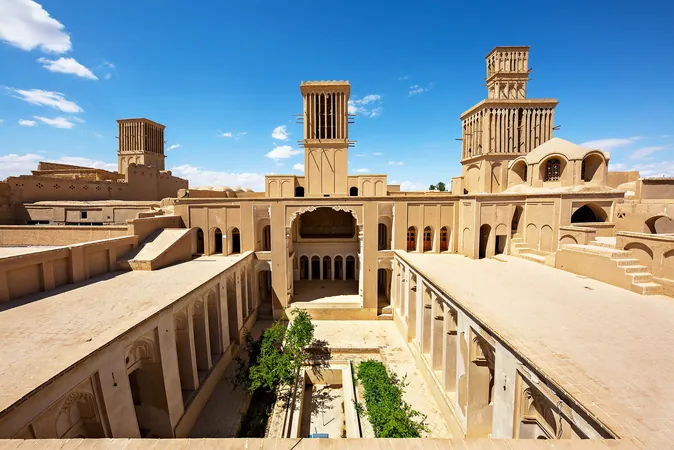
How Ancient Cooling Techniques Can Save Us from Scorching Heat and Power Outages
2025-01-12
Author: Wei Ling
In today's society, buildings often rely heavily on air conditioning and sealed windows, giving us a false sense of security during sweltering summer days. However, as we have seen with recent blackouts across the country, these modern conveniences can fail when we need them most. The resulting heat can turn our homes into stifling ovens, proving the importance of passive cooling methods.
Ancient Wisdom: Mastering Natural Cooling
Long before the advent of electricity, ancient civilizations developed ingenious construction techniques to combat the intense heat of summer. For instance, builders from various regions created thick walls that absorbed the sun's heat during the day and released it during the cooler nighttime hours.
Dr. Pablo La Roche, an architecture professor specializing in sustainable design at California State Polytechnic University, Pomona, emphasizes how these historical approaches hold great relevance today. His research into passive cooling systems showcases their effectiveness in mitigating the harsh climates we experience more frequently.
The Sumerians’ Solution in Ancient Iraq
In southern Iraq, the Sumerians constructed homes with series of innovative design elements to shield against the blistering sun. Their mud-brick structures featured thick walls and small windows, significantly reducing heat accumulation during the day. Furthermore, the layout of neighborhoods, with homes closely spaced, minimized the heat exposure on individual walls. Streets were intentionally designed to create shade, offering relief to pedestrians.
Such designs created comfortable indoor environments where families could congregate in courtyards, enjoying light breezes while staying shielded from intense sunlight.
Lessons for Modern Architecture
Recent power outages, like those experienced in Houston during a severe heat wave in July 2024, have revealed the dangers of relying solely on air conditioning. High-rise buildings, once thought secure, turned unbearable without electricity. This has prompted architects to reconsider integrating features like operable windows, ample thermal mass, and decorative rooftop structures into new designs to enhance airflow and reduce energy consumption.
Ancient Egypt's Ingenious Ventilation
Egyptians also mastered the art of passive cooling. Utilizing mud brick for its thermal properties, they built structures that blocked harsh sunlight. Rooftop living allowed them to take advantage of cooler nightly temperatures. Critically, they invented the mulqaf, a wind catcher that siphoned in breezes, circulating fresh air and exhausting warmer air through strategically placed vents.
This ancient air conditioning system is still echoing in modern architecture across the Middle East, proving that some innovations stand the test of time.
Strategies from the Ancestral Puebloans
In the Southwestern U.S., the ancestral Puebloans adeptly constructed their homes using stone and adobe, focusing on communal designs that utilized natural shading provided by nearby cliffs. Their strategic orientation and placement of smaller windows reduced heat gain in summer while allowing winter sunlight to warm interiors.
Rainwater Management: A Game-Changer
Where many modern cities swiftly divert stormwater, historical societies knew better. For example, Muslim caliphates across northern Africa and southern Spain ingeniously captured and stored every drop of rainwater, utilizing it to cool their homes and nourish gardens. Similarly, the Mayans created vast reservoirs for storing seasonal rainfall.
Today, efforts are underway to reignite interest in rainwater harvesting, especially pertinent for cities facing droughts and water scarcity.
Embracing Passive Cooling for a Sustainable Future
Architects and urban planners are now focusing on designs that highlight passive cooling and water preservation. Positioning buildings to leverage south-facing windows and maximizing onsite rainwater harvesting can drastically decrease reliance on centralized water supplies.
As urban areas seek to curb energy consumption and maintain livability during outages, integrating ancient wisdom into modern designs seems not only plausible but necessary. While some may view these methods as outdated, their historical success offers valuable lessons for navigating contemporary climate challenges.
Moving Toward a Resilient and Efficient Future
As extreme heat events become increasingly common, the call for reimagining our reliance on electrical power grows louder. The strategies used by ancient civilizations, which depended on local resources and a profound understanding of nature, can inform our approach to building more resilient cities.
It’s time to move away from glass towers and single-purpose rooftops and adapt design principles from the past to tackle the realities of our present climate. The knowledge gained from previous generations is invaluable, providing a roadmap for creating comfortable living spaces when modern conveniences are out of reach.
Stay informed and explore how our historical innovations can inspire a sustainable future.


 Brasil (PT)
Brasil (PT)
 Canada (EN)
Canada (EN)
 Chile (ES)
Chile (ES)
 Česko (CS)
Česko (CS)
 대한민국 (KO)
대한민국 (KO)
 España (ES)
España (ES)
 France (FR)
France (FR)
 Hong Kong (EN)
Hong Kong (EN)
 Italia (IT)
Italia (IT)
 日本 (JA)
日本 (JA)
 Magyarország (HU)
Magyarország (HU)
 Norge (NO)
Norge (NO)
 Polska (PL)
Polska (PL)
 Schweiz (DE)
Schweiz (DE)
 Singapore (EN)
Singapore (EN)
 Sverige (SV)
Sverige (SV)
 Suomi (FI)
Suomi (FI)
 Türkiye (TR)
Türkiye (TR)
 الإمارات العربية المتحدة (AR)
الإمارات العربية المتحدة (AR)